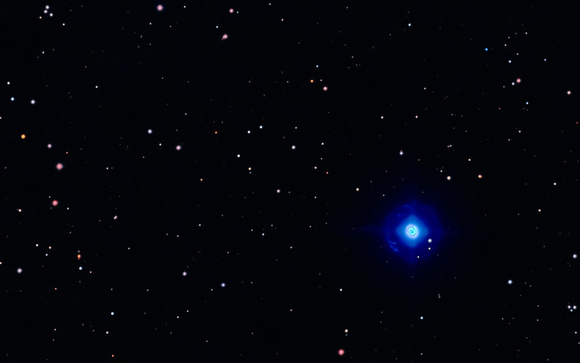Blue Snowball PN (NGC7662) in SHO with RGBish stars
NGC7662 - Blue Snowball Planetary Nebula (Andromeda) - Oct 2022
Planewave CDK12.5 - AIS6200MM
A-P 1100 GTO AE, Antlia Pro 3nm NB & BB filters
H, O filters: (2 x 21 x 360s exposures, Bin 1x1, Gain 100 &
2 x 21 x 120s exposures, Bin 1x1, Gain 0 &
2 x 41 x 20s exposures, Bin 1x1, Gain 0)
S filter: (22 x 240s exposures, Bin 1x1, Gain 100)
R,G,B filters (3 x 15 x 120s exposures, Bin 1x1, Gain 0)
Total Integration Time = 7.62 hours
The Blue Snowball Nebula in Andromeda is a fairly close (5600 ly est), but small (0.8ly across), and its core occpies 0.28 arcminutes of sky. It is popular with visual observers as it is very bright and appears surrounded by a faint blue disc of nebulosity. Little did I know what a challenge this would be to image and process.
Processing ended up being an exercise in dynamic range and contrast distribution. For imaging, Ha and O filters required shooting at a wide variety of exposure times and gains in order to capture both detail in the bright core, which was overexposed with high gain/long exposures and the dim nebulosity, which was underexposed with low gain/short exposures.
In the end, I had to pull out all of my skills to tame this beast. The best combination, at least for me, was careful stretching with GHS to bring out the nebulosity while protecting the brights both before and after linear HDR composition and HDRMT processing.
What also made processing difficult was that star removal insisted on including the PN as a star because it was the brightest object (including actual stars) in the entire field of view. Only when stretching was nearly completed would the star removal AI decide that the PN was not a star, but then it decided that some real stars weren't stars too.
The lack of star removal meant that deconvolution and HDRMT were very difficult, and that replacement of SHO stars with RGB ones was extremely difficult. Some of the stars were left with Ha signal or halos superimposed on the RGB stars.
In the end, this little PN was the my most difficult image to process to date.


